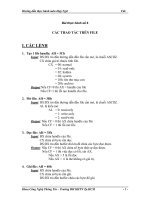[C++]Các thao tác trên file doc
Bạn đang xem bản rút gọn của tài liệu. Xem và tải ngay bản đầy đủ của tài liệu tại đây (117.75 KB, 15 trang )
[C++]Các thao tác trên file
Trong C++ thì ta có 3 loại File stream cơ bản sau :
ifstream : Dùng cho file nhập vào. Loại này chỉ có thể được dùng để đọc dữ
liệu vào file vào bộ nhớ mà thôi.
ofstream : Dùng cho file xuất ra. Loại này thì có thể dùng để tạo ra files và
chép dữ liệu vào chúng.
fstream : Đây là kênh file.(File stream). Loại này thì có thể vừa tạo file, vừa
ghi dữ liệu vào file và đọc dữ dữ liệu từ file vào luôn.
I.Cách sử dụng fstream :
Để định nghĩa 1 đối tượng file ta dùng cú pháp sau :
fstream dataFile
Ở đây dataFile chỉ là tên do người dùng đặt mà thôi.
Để mở 1 file ta dùng cú pháp sau :
dataFile.open("info.txt", ios::out);
Ở đây hàm open đòi hỏi 2 đối số : đối thứ nhất là 1 chuỗi tên chứa tên file. Đối
thứ 2 là 1 flag của file và cái này cho ta biết chế độ nào mà chúng ta dùng để
mở file. Ở ví dụ trên thì tên file là info.txt còn flag file ở đây là ios::out. Cái
này nó nói cho C++ biết chúng ta mở file ở chế độ xuất ra.
Chế độ xuất ra cho phép dữ liệu có thể được ghi vào file.
datafile.open("info.txt", ios::in);
Còn ở ví dụ này thì tức là ta đang mở file ở chế độ nhập vào, tức là cho phép
dữ liệu được đọc vào từ file.
Chúng ta có 1 số chế độ cơ bản sau đây :
ios::app Chế độ gắn vào. Nếu file đã được tạo thì nội dung của nó sẽ được gắn
vào tận cùng của file. Theo mặc định thì đối với chế độ này thì nếu file chưa
được tạo nó sẽ tạo ra 1 file mới.
ios::ateNếu file đã được tạo, thì chương trình sẽ chạy tới trực tiếp chỗ cuối
cùng của file. Xuất ra có thể là được ghi ra bất kì chỗ nào trong file.
ios::binaryChế độ nhị phân. Khi mà file được mở ra ở chế độ này thì dữ liệu sẽ
được đọc hay ghi từ 1 định dạng nguyên thủy nhị phân.
ios::truncNếu file đã được tạo thì nội dung của nó sẽ bị xóa đi.
Chúng ta còn có thể sử dụng những chế độ trên chung với nhau và chúng sẽ
được kết nối với nhau bằng toán tử |. Ví dụ
dataFile.open("info.txt", ios::in | ios::out);
Dòng lệnh trên cho phép ta mở file info.txt ở cả 2 chế độ xuất và nhập.
Chú ý : Khi dùng riêng lẻ thì ios::out sẽ xóa nội dung của file nếu file đã được
tạo sẵn. Tuy nhiên nếu dùng chung với ios::in, thì nội dung file cũ sẽ được giữ
lại. Và nếu file chưa được tạo, nó sẽ tạo ra 1 file mới cho chúng ta luôn.
Bây h là 1 ví dụ hoàn chỉnh :
program 1
// This program uses an fstream object to write data to a file. #include
<iostream> #include <fstream> using namespace std; int main() { fstream
dataFile; cout << "Opening file \n";
dataFile.open("demofile.txt", ios::out); // Mở file để ghi vào
cout << "Now writing data to the file.\n";
dataFile << "Jones\n"; // Ghi dòng thứ 1
dataFile << "Smith\n"; // Ghi dòng thứ 2
dataFile << "Willis\n"; // Ghi dòng thứ 3
dataFile << "Davis\n"; // Ghi dòng thứ 4
dataFile.close(); // Đóng file
cout << "Done.\n";
return 0;
}
Program Output
Opening file
Now writing data to the file.
Done.
File Output
Jones
Smith
Willis
Davis
Bây h là 1 ví dụ khác, chỉnh sữa lại ví dụ trên 1 tí. Và chúng ta sẽ thêm vào chế
độ ios::app. Chúng ta sẽ mở file ra ghi vào 2 tên sau đó đóng lại rồi lại mở ra
ghi vào tiếp thêm 2 tên nữa.
program 2
// This program writes data to a file, closes the file, // then reopens the file and
appends more data. #include <iostream> #include <fstream> using namespace
std; int main() { ofstream dataFile; cout << "Opening file \n";
//Mở file ở chế độ xuất
dataFile.open("demofile.txt", ios::out);
cout << "Now writing data to the file.\n";
dataFile << "Jones\n"; // Ghi dòng thứ 1
dataFile << "Smith\n"; // Ghi dòng thứ 2
cout << "Now closing the file.\n";
dataFile.close(); // Đóng file
cout << "Opening the file again \n";
// Mở file ở chế độ gắn vào.
dataFile.open("demofile.txt", ios::out | ios::app);
cout << "Writing more data to the file.\n";
dataFile << "Willis\n"; // Ghi dòng thứ 3
dataFile << "Davis\n"; //Ghi dòng thứ 4
cout << "Now closing the file.\n";
dataFile.close(); // Đóng file
cout << "Done.\n";
return 0;
}
Output File
Jones
Smith
Willis
Davis
Ở ví dụ 2 này ta có thể hìng dung như sau :
J O N E S \n S M I T H H \n <EOF>
Khi file được đóng lại thì kí tự end-of-file sẽ được tự động ghi vào. Khi file lại
được mở ra thì dữ liệu mới lại được gắn vào chỗ end-of-file đó.
J O N E S \n S M I T H H \n W I L L I S \n D A V I S \n <EOF>
Chú ý : nếu chúng ta thử bỏ thằng ios::out đứng 1 mình mà không có ios::app
thì lần thứ 2 mở file là nội dung đầu sẽ bị xóa hết ( tức là 2 cái tên John và
Smith sẽ bị xóa ) Và lần thứ 2 mở ra ghi lại thì cuối cùng ta chỉ còn 2 tên là
Willis and Davis.
Chúng ta đã thấy mặc dù 2 thằng ifstream và ofstream chỉ giới hạn 1 cái được
nhập vào và 1 cái xuất ra nhưng nếu sử dụng với những chế độ ios:: khác nhau
thì ta có thể vừa xuất vừa nhập như thường.
II.Kiểm tra file có tồn tại hay không trước khi mở :
Đôi khi chúng ta sẽ cần quyết định xem file có tồn tại trước khi chúng ta mở nó
ra hay không và sau đây là 1 ví dụ.
fstream dataFile; dataFile.open("value.txt", ios::in);
if(dataFile.fail())
{
//Nếu file không tồn tại, thì tạo ra 1 file mới
dataFile.open("value.txt", ios::out);
//
}
else
{
dataFile.close();
}
III.Định dạng file xuất ra :
program 3
// This program uses the setprecision and fixed // manipulators to format file
output. #include <iostream> #include <iomanip> #include <fstream> using
namespace std; int main() { fstream dataFile; double num = 17.816392;
dataFile.open("numfile.txt", ios::out);
dataFile << fixed; // Định dạng fixed-point
dataFile << num << endl; //Xuất ra num
dataFile << setprecision(4); // Định dạng 4 phần thập phân sau dấu .
dataFile << num << endl; //Xuất ra num
dataFile << setprecision(3); // Định dạng 3 phần thập phân sau dấu .
dataFile << num << endl; // Xuất ra num
dataFile << setprecision(2); // 2 phần
dataFile << num << endl; // xuất ra
dataFile << setprecision(1); // 1 phần
dataFile << num << endl; // xuất ra
cout << "Done.\n";
dataFile.close(); // Đóng file
return 0;
}
Output
17.816392
17.8164
17.816
17.82
17.8
program 4
// This program writes three rows of numbers to a file. #include <iostream>
#include <fstream> #include <iomanip> using namespace std; int main() {
const int ROWS = 3; //Dòng const int COLS = 3; //Cột int
nums[ROWS][COLS] = { 2897, 5, 837, 34, 7, 1623, 390, 3456, 12 }; fstream
outFile("table.txt", ios::out);
//Ghi dữ liệu ra với khoảng cách là 8
for (int row = 0; row < ROWS; row++)
{
for (int col = 0; col < COLS; col++)
{
outFile << setw(8) << nums[row][col];
}
outFile << endl;
}
outFile.close();
cout << "Done.\n";
return 0;
}
IV.Cách truyền 1 file name vào hàm :
Chúng ta khi làm việc với những chương trình thực sự thì đôi khi chúng ta cần
phải truyền 1 tên file vào hàm nào đó để tiện cho việc quản lý, nhưng khi
truyền phải lưu ý là luôn luôn truyền bằng tham chiếu
program 5
#include <iostream> #include <fstream> #include <string> using namespace
std; bool OpenFile(fstream &file, char *name); void ShowContents(fstream
&file); int main() { fstream dataFile; if(!OpenFile(dataFile, "demo.txt"))
{
cout << "Error !" << endl;
return 0;
}
cout << "Successfully.\n";
ShowContents(dataFile);
dataFile.close();
return 0;
}
bool OpenFile(fstream &file, char *name)
{
file.open(name, ios::in);
if(file.fail())
return false;
else
return true;
}
void ShowContents(fstream &file)
{
string line;
while(getline(file, line)){
cout << line << endl;
}
}
Nội dung file:
wow
ohlalal 32131
hehe
hoho Output
Successfully.
wow
ohlalal 32131
hehe
hoho
Press any key to continue . . .
V.Dùng hàm thành viên để đọc và ghi file :
Khoảng trắng (Whitespace) là 1 kí tự mà nó là 1 phần của dữ liệu, vấn đề sẽ
nảy sinh khi ta đoc vào bằng toán tử >>. Bởi vì toán tử >> nó xem khoảng
trắng như 1 kí tự kết thúc (delimiter), vì thế nó sẽ không đọc chúng vào. Xem
ví dụ sau :
program 6
// This program demonstrates how the >> operator should not // be used to read
data that contains whitespace characters // from a file. #include <iostream>
#include <fstream> using namespace std; int main() { const int SIZE = 81; //
Size của mãng input char input[SIZE]; // Mãng lưu input fstream nameFile;
//Mở file ở chế độ đọc nameFile.open("murphy.txt", ios::in);
if (!nameFile)
{
cout << "ERROR: Cannot open file.\n";
return 0;
}
//Đọc nội dung file.
while (nameFile >> input)
{
cout << input;
}
nameFile.close();
return 0;
}
Nội dung file
Jayne John
47 Circle street
CA 93065
Output
JayneJohn47Circle streetCA93065
Chúng ta sẽ dùng hàm getline để xử lý những trường hợp như vậy.
program 7
// This program uses the file stream object's getline member // function to read
a line of data from the file. #include <iostream> #include <fstream> using
namespace std; int main() { const int SIZE = 81; char input[SIZE]; fstream
nameFile; nameFile.open("murphy.txt", ios::in);
if (!nameFile)
{
cout << "ERROR: Cannot open file.\n";
return 0;
}
nameFile.getline(input, SIZE); //Dùng kí tự mặc định \n như kí tự kết thúc.
while (!nameFile.eof())
{
cout << input << endl;
nameFile.getline(input, SIZE); //Chỗ này cũng vậy.
}
nameFile.close();
return 0;
}
Output
Jayne John
47 Circle street
CA 93065
Hoặc nếu không thích dùng kí tự mặc định '\n' của hàm getline() thì ta có thể
dùng 1 kí tự bất kì khác như sau ví dụ :
program 8
// This file demonstrates the getline function with a user- // specified delimiter.
#include <iostream> #include <fstream> using namespace std; int main() {
const int SIZE = 81; char input[SIZE]; fstream dataFile("names2.txt", ios::in);
// Bây h dùng kí tự $ là kí tự kết thúc.
dataFile.getline(input, SIZE, '$');
while (!dataFile.eof())
{
cout << input << endl;
dataFile.getline(input, SIZE, '$');
}
dataFile.close();
return 0;
}
Nội dung file
JayneJohn\n$47Circle street\n$CA93065\n$
Output
Trích dẫn:
Jayne John
47 Circle street
CA 93065
Phần II
I.Hàm get() :
Hàm get()là 1 hàm rất hữu dụng trong việc thao tác với file. Ví dụ :
inFile.get(ch);
Trong ví dụ trên thì ch là 1 biến kiểu char. Một kí tự sẽ được đọc vào từ file và
lưu vào ch. Chương trình sau sẽ là 1 demo cho cách dùng get.
program 1
// This program asks the user for a file name. The file is // opened and its
contents are displayed on the screen. #include <iostream> #include <fstream>
using namespace std; int main() { const int SIZE = 51; // Array size for file
name char fileName[SIZE]; // To hold the file name char ch; // To hold a
character fstream file; // File stream object // Get the file name cout <<
"Enter a file name: ";
cin >> fileName;
// Open the file.
file.open(fileName, ios::in);
if (!file)
{
cout << fileName << " could not be opened.\n";
return 0;
}
// Get each character from the file and display them.
file.get(ch);
while (!file.eof())
{
cout << ch;
file.get(ch);
}
// Close the file.
file.close();
return 0;
}
Chương trình trên sẽ xuất ra nội dung của bất kì file như thế nào. Hàm get() sẽ
đọc luôn những kí tự trắng vì thế nội dung file sẽ y chang như nó xuất hiện
trong file.
II.Hàm put()
Hàm get sẽ ghi 1 kí tự vào file. Ví dụ :
outFile.put(ch);
Trong ví dụ trên thì biến ch là kiểu char.
Ví dụ về cách dùng put()
program 2
// This program demonstrates the put member function. #include <iostream>
#include <fstream> using namespace std; int main() { char ch; // To hold a
character // Open the file for output. fstream dataFile("sentence.txt", ios::out);
cout << "Type a sentence and be sure to end it with a ";
cout << "period.\n";
// Get a sentence from the user one character at a time
// and write each character to the file.
cin.get(ch);
while (ch != '.')
{
dataFile.put(ch);
cin.get(ch);
}
dataFile.put(ch); // Write the period.
// Close the file.
dataFile.close();
return 0;
}
III. Các xử lý với nhiều file :
program 3
// This program demonstrates reading from one file and writing // to a second
file. #include <iostream> #include <fstream> #include <cctype> // Needed for
the toupper function. using namespace std; int main() { const int SIZE = 51; //
Array size for file name char fileName[SIZE]; // To hold the file name char ch;
// To hold a character ifstream inFile; // Input file // Open a file for output.
ofstream outFile("out.txt");
// Get the input file name.
cout << "Enter a file name: ";
cin >> fileName;
// Open the file for input.
inFile.open(fileName);
if (!inFile)
{
cout << "Cannot open " << fileName << endl;
return 0;
}
// Process the files.
inFile.get(ch); // Get a char from file 1
while (!inFile.eof()) // Test for end of file
{
outFile.put(toupper(ch)); // Write uppercase char to file 2
inFile.get(ch); // Get another char from file 1
}
// Close the files.
inFile.close();
outFile.close();
cout << "File conversion done.\n";
return 0;
}
VI.File nhị phân :
Định nghĩa : File nhị phân là file chứa nội dung không nhất thiết phải là ASCII
text.
Tất cả những file từ đầu tới h chúng ta thao tác đều là tẽt files. Có nghĩa là dữ
liệu trong những file này đều đã được định dạng dưới mã ASCII. Thậm chí là
số đi chăng nữa khi nó được lưu trong file với toán tử << thì nó đã đc ngầm
định chuyển về dạng text. Ví dụ :
ofstream file("num.dat");
short x = 1297;
file << x;
Dòng lệnh cuối cùng của ví dụ trên sẽ ghi nội dung của x vào file. Và chúng
được lưu vào ở dạng kí tự '1', '2', '9', '7'.
Thực sự là con số 1297 không hề được lưu trong bộ nhớ. Nó đã được định
dạng thành 1 số nhị phân, và chiếm 2 byte trong bộ nhớ máy tính.
Vì x kiểu short nó sẽ được lưu như sau :
00000101 | 00010001
Và đây chính là dữ liệu nguyên thuỷ được lưu trong bộ nhớ.
Và để làm được như vậy chúng ta sẽ có cú pháp như sau :
file.open("stuff.dat", ios::out | ios::binary);
Ghi chú : mặc định của complier thì file sẽ được mở ở định dạng text.
V. Hàm write và read :
1.Write
-Hàm write dùng để ghi 1 file stream ở định dạng nhị nhận. Dạng tổng quát của
hàm write như sau :
fileObject.write(address, size);
Ở đây chúng ta có những lưu ý sau :
-fileObject là tên của đối tượng file stream.
-address là địa chỉ đầu tiên của 1 vùng nhớ được ghi vào file. Đối số này có thể
là địa chỉ của 1 kí tự hoặc là con trỏ tới kiểu char.
-size là số lượng byte của vùng nhớ mà nó được write. Đối số này bắt buộc
phải là kiểu integer( số nguyên dương )
Chúng ta xét ví dụ sau :
PHP Code:
char letter = 'A';
file.write(&letter, sizeof(letter));
-Đối thứ nhất ở đây là địa chỉ của biến letter. Và đối này sẽ nói cho hàm write
biết rằng dữ liệu được ghi vào file ở đâu trong vùng nhớ.
-Đối thứ 2 sẽ là kíck thước của biến letter, và đối này sẽ nói cho hàm write biết
số lượng byte của dữ liệu sẽ ghi vào file. Bởi vì dữ sẽ được lưu khác nhau trên
tuỳ hệ thống khác nhau, nên cách tốt nhất là chúng ta dùng toán tử sizeof để
quyết định số bytes được ghi. Và sau khi hàm này được thực hiện, nội dung
của biến letter sẽ được khi vào file nhị phân của đối tượng "file"đó.
Chúng ta xem tiếp 1 ví dụ sau :
PHP Code:
char data[] = {'A', 'B', 'C', 'D'};
file.write(data, sizeof(data));
Trong ví dụ này thì đối thứ 1 là tên của mãng (data). Vì khi ta truyền tham số
là tên của mãng thì tức là ta đã truyền con trỏ trỏ tới vị trí đầu tiên của mãng.
Đối thứ 2 cũng có ý nghĩa tượng tự như ví dụ 1. Và sau khi gặp này thực hiện
thì nội dung của mãng sẽ được ghi vào file nhị phân tương ứng với đối tượng
file.
2.Read:
Hàm read thì sẽ dùng đọc vào số dữ liệu nhị phân từ file vào bộ nhớ máy tính.
Dạng tổng quát là :
fileObject.read(address, size);
-Ở đây fileObject là tên của đối tượng file stream.
-address là địa chỉ đầu tiên mà vùng nhớ mà dữ liệu được đọc vào được lưu.
Và đối này có thể là địa chỉ của 1 kí tự hay 1 con trỏ tới kiểu char.
-size cũng là số lượng byte trong bộ nhớ được đọc vào từ file. Và đối này bắt
buộc cũng phải là số kiểu integer ( nguyên dương )
.
Tương tự hàm read ta cũng có 2 ví dụ sau :
char letter;
file.read(&letter, sizeof(letter));
Và :
char data[4];
file.read(data, sizeof(data));
Chương trình sau sẽ minh hoạ cách sử dụng 2 hàm read and write :
[b]program 4[/b] // This program uses the write and read functions. #include
<iostream> #include <fstream> using namespace std; int main() { const int
SIZE = 4; char data[SIZE] = {'A', 'B', 'C', 'D'}; fstream file; // Open the file for
output in binary mode. file.open("test.dat", ios::out | ios::binary);
// Write the contents of the array to the file.
cout << "Writing the characters to the file.\n";
file.write(data, sizeof(data));
// Close the file.
file.close();
// Open the file for input in binary mode.
file.open("test.dat", ios::in | ios::binary);
// Read the contents of the file into the array.
cout << "Now reading the data back into memory.\n";
file.read(data, sizeof(data));
// Display the contents of the array.
for (int count = 0; count < SIZE; count++)
cout << data[count] << " ";
cout << endl;
// Close the file.
file.close();
return 0;
}
Nếu chúng ta muốn ghi các kiểu khác vào file nhị phân thì ta phải dùng cú
pháp có 1 tí đặt biệt sau đây.
reinterpret_cast<dataType>(value)
Ở cú pháp trên thì dataType sẽ là kiểu dữ liệu mà chúng ta muốn ép về, và
value sẽ là giá trị mà chúng ta muốn ép.
Ví dụ :
int x = 65; file.write(reinterpret_cast<char *>(&x), sizeof(x));
Đối với mãng thì :
const int SIZE = 10; int numbers[SIZE] = {1,2,3,4,5,6,7,8,9,10};
file.write(reinterpret_cast<charr *>(numbers), sizeof(numbers));
program 5
// This program uses the write and read functions. #include <iostream>
#include <fstream> using namespace std; int main() { const int SIZE = 10;
fstream file; int numbers[SIZE] = {1, 2, 3, 4, 5, 6, 7, 8, 9, 10}; // Open the file
for output in binary mode. file.open("numbers.dat", ios::out | ios::binary);
// Write the contents of the array to the file.
cout << "Writing the data to the file.\n";
file.write(reinterpret_cast<char *>(numbers), sizeof(numbers));
// Close the file.
file.close();
// Open the file for input in binary mode.
file.open("numbers.dat", ios::in | ios::binary);
// Read the contents of the file into the array.
cout << "Now reading the data back into memory.\n";
file.read(reinterpret_cast<char *>(numbers), sizeof(numbers));
// Display the contents of the array.
for (int count = 0; count < SIZE; count++)
cout << numbers[count] << " ";
cout << endl;
// Close the file.
file.close();
return 0;
}
Nguồn: congdongcviet.com









